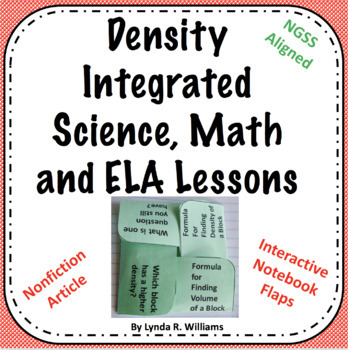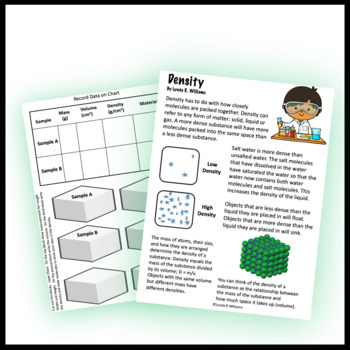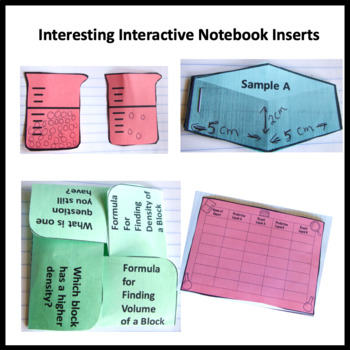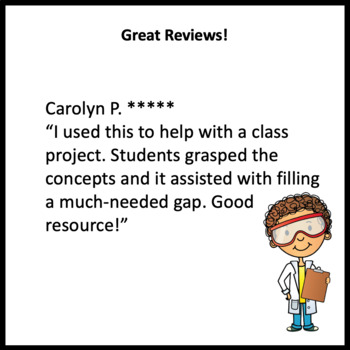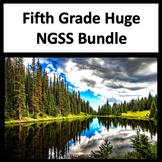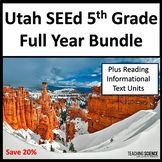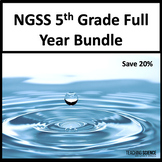Density Integrated Science, Math and ELA Lessons NGSS Aligned.
- PDF
What educators are saying
Also included in
- This is a collection of labs and science experiments for chemical reactions and density. Enjoy this collection here at a 20% discount. Students will enjoy these hands-on colorful and engaging science experiments. This unit includes chemical reactions and density experiments.This resource includes HPrice $31.32Original Price $39.30Save $7.98
- Do you teach 5th-grade science? You will love my 5 e-science lessons and my phenomena-based units for 5th-grade science! This bundle also includes reading informational text units with a science theme. Purchase in the bundle and save 20%. You will love this excellent bundle for fifth-grade science.Price $116.88Original Price $146.10Save $29.22
- 5th Grade Utah SEEd Bundle: This is a year's worth of lessons and units that address all of the Utah SEEd standards for 5th grade. These units use phenomena, science and engineering practices, and crosscutting concepts to help students think critically and deepen their understanding. Save 20% by purPrice $113.23Original Price $141.54Save $28.31
- This Bundle for Utah SEEd 5th grade includes science resources for each strand and standard. Each unit addresses specific Utah SEEd standards for 5th grade. Students will love these engaging activities for Utah SEEd 5th Grade. You will love saving time by having someone creating resources who reallyPrice $80.44Original Price $100.55Save $20.11
- Do you teach 5th-grade science? This bundle covers all the standards for NGSS 5th grade for the entire year. This year-long 5th-grade science bundle is outstanding! You save 20% by purchasing this bundle. If you teach 5th grade in an NGSS state, you need this bundle. Each unit is complete and addresPrice $76.04Original Price $97.05Save $21.01
Description
Density is an interesting property of matter. This unit starts with phenomena. This resource integrates three subjects into two great lessons on density. The integrated math, ELA, and science lessons on density will help your students understand this concept. Students will learn about density in solids and how to calculate the volume of a rectangular solid.
This Density Unit Includes:
•Step By Step Directions
•Two Lesson plans
•Reading passage
•Follow up pages
•Interactive notebook inserts
NGSS Alignment:
NGSS 5-PS1-1.
Develop a model to describe that matter is made of particles too small to be seen.
NGSS 5-PS1-3.
Make observations and measurements to identify materials based on their properties.
NGSS MS-PS1-2.
Analyze and interpret data on the properties of substances before and after the substances interact to determine if a chemical reaction has occurred.
Utah SEEd 5.2.1 Develop and use a model to describe that matter is made of particles on a scale that is too small to be seen.
And the Utah SEEd 6.2 Density describes how closely matter is packed together. Substances with a higher density have more matter in a given space than substances with a lower density. Changes in heat energy can alter the density of a material.
CCSS.MATH.CONTENT.6.G.A.2
Find the volume of a right rectangular prism with fractional edge lengths by packing it with unit cubes of the appropriate unit fraction edge lengths, and show that the volume is the same as would be found by multiplying the edge lengths of the prism.
This resource contains two hands-on lessons. One explores density in liquids and one explores density in solids. Students will practice reading skills for reading informational text including answering text dependent questions after the read the nonfiction article provided.
Students will used measurement and formulas to find the volume, mass and density of solid objects.
Interactive notebook flaps are included.
NGSS Science and Engineering Practices used in These Lessons:
1. Asking questions
2. Developing and using models
3. Planning and carrying out investigations
4. Analyzing and interpreting data
5. Using mathematics and computational thinking
6. Constructing explanations (
7. Engaging in argument from evidence
8. Obtaining, evaluating, and communicating information
Science Concepts
Density
Molecules
Volume
Mass
Reading Skills
Main Idea
Author's Purpose
Vocabulary
Math skills
Measurement
Calculating Volume
multiplication
Division
Calculating Density
This resource is also available in the following bundles that will save you 20%!
Save 20% by purchasing in the Utah SEEd 5th-grade Bundle.
Save 20% by purchasing in the NGSS 5th Grade Bundle
Density Bundle NGSS Aligned Save 20 Percent
NGSS Middle School Physical Science Bundle
Utah SEEd 6.2 Strand Physical Science Bundle
Save 20% by purchasing in Utah SEEd 5th Grade PLUS Reading Units Bundle
Save money and purchase in the Utah SEEd 6.2 Bundle
Please view my other science resources:
Bundle of Colorful Exciting Science Lessons

